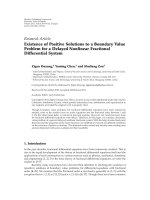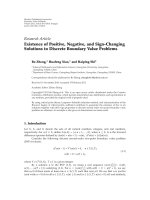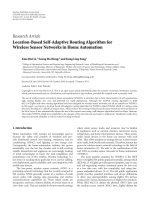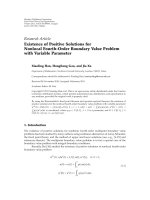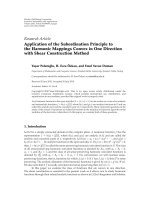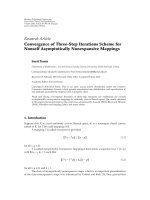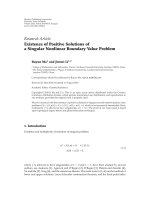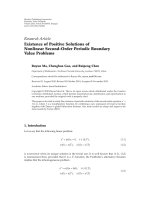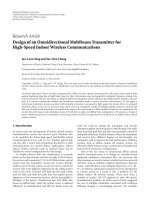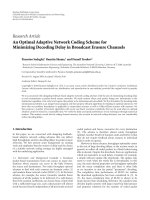Báo cáo hóa học: " Research Article Multiplicity of Positive and Nodal Solutions for Nonhomogeneous Elliptic Problems in Unbounded Cylinder Domains" pdf
Bạn đang xem bản rút gọn của tài liệu. Xem và tải ngay bản đầy đủ của tài liệu tại đây (591.67 KB, 20 trang )
Hindawi Publishing Corporation
Boundary Value Problems
Volume 2009, Article ID 687385, 20 pages
doi:10.1155/2009/687385
Research Article
Multiplicity of Positive and Nodal Solutions for
Nonhomogeneous Elliptic Problems in Unbounded
Cylinder Domains
Tsing-San Hsu
Center for General Education, Chang Gung University, Kwei-San, Tao-Yuan 333, Taiwan
Correspondence should be addressed to Tsing-San Hsu,
Received 13 March 2009; Accepted 7 May 2009
Recommended by Zhitao Zhang
We show that if ax and fx satisfy some suitable conditions, then the Dirichlet problem
−Δu u ax|u|
p−2
u fx in Ω has a solution that changes sign in Ω, in addition to two positive
solutions where Ω is an unbounded cylinder domain in
R
N
.
Copyright q 2009 Tsing-San Hsu. This is an open access article distributed under the Creative
Commons Attribution License, which permits unrestricted use, distribution, and reproduction in
any medium, provided the original work is properly cited.
1. Introduction
Throughout this paper, let x y, z be the generic point of R
N
with y ∈ R
m
, z ∈ R
n
, where
N m n ≥ 3,m≥ 2,n≥ 1, 2 <p<
2N
N − 2
. 1.1
In this paper, we study the multiplicity results of both positive and nodal solutions for the
nonhomogeneous elliptic problems
−Δu u a
x
|
u
|
p−2
u f
x
in Ω,u∈ H
1
0
Ω
, 1.2
where 0 ∈ ω ⊆ R
m
is a bounded smooth domain, Ωω ×R
n
is a smooth unbounded cylinder
domain in R
N
.
2 Boundary Value Problems
It is assumed that ax and fx satisfy the following assumptions:
a1 ax is continuous and ax ∈ 0, 1 on
Ω, and
lim
|
z
|
→∞
a
x
1 uniformly for y ∈ ω; 1.3
f 1 fx ≥ 0,fx
/
≡0,fx ∈ H
−1
Ω;
f 2 γ
f
> 0 in which we defined
γ
f
inf
1
p − 1
p−1/p−2
p − 2
u
2p−1/p−2
−
Ω
fudx :
Ω
a
x
|
u
|
p
dx 1
;
1.4
f 3 there exist positive constants C
0
,
0
,R
0
such that
f
x
≤ C
0
exp
−
1 μ
1
0
|
z
|
for
|
z
|
≥ R
0
, uniformly for y ∈ ω, 1.5
where μ
1
is the first positive eigenvalue of the Dirichlet problem −Δ in ω.
For the homogeneous case, that is, fx ≡ 0, Zhu 1 has established the existence of
a positive solution and a nodal solution of problem 1.2 in H
1
R
N
provided ax satisfies
ax ≥ 1inR
N
and ax − 1 ≥ C/|x|
l
as |x|→∞for some positive constants C and l.More
recently, Hsu 2 extended the results of Zhu 1 with R
N
to an unbounded cylinder Ω.Let
us recall that, by a nodal solution we mean the solution of problem 1.2 with change of sign.
For the nonhomogeneous case fx
/
≡0, Adachi and Tanaka 3 have showed that
problem 1.2 has at least four positive solutions in H
1
R
N
for ax and fx satisfy some
suitable conditions, but we place particular emphasis on the existence of nodal solutions.
More recently, Chen 4 considered the multiplicity results of both positive and nodal
solutions of problem 1.2 in H
1
R
N
. She has showed that problem 1.2 has at least two
positive solutions and one nodal solution in H
1
R
N
when ax and fx satisfy some
suitable assumptions.
In the present paper, motivated by 4 we extend and improve the paper by Chen 4.
We will deal with unbounded cylinder domains instead of the entire space and also obtain
thesameresultsasin4. Our arguments are similar to those in 5, 6, which are based on
Ekeland’s variational principle 7.
Now, we state our main results.
Theorem 1.1. Assume a1, f1, f2 hold and ax satisfies assumption a2.
a2 there exist positive constants C, δ
0
,Rsuch that
a
x
≥ 1 − C exp
−
1 μ
1
δ
0
|
z
|
for
|
z
|
≥ R, uniformly for y ∈
ω. 1.6
Boundary Value Problems 3
Then problem 1.2 has at least two positive solutions u
0
and u
1
in H
1
0
Ω. Furthermore, u
0
and u
1
satisfy 0 <u
0
<u
1
, and u
0
is a local minimizer of I where I is the energy functional of problem 1.2.
Theorem 1.2. Assume a1, f1, f2, f3 hold and ax satisfies assumption a3.
a3 there exist positive constants
C, R, and δ
0
< 1 μ
1
such that
a
x
≥ 1
C exp
−
1 μ
1
− δ
0
|
z
|
for
|
z
|
≥
R, uniformly for y ∈ ω. 1.7
Then problem 1.2 has a nodal solution in H
1
0
Ω in addition to two positive solutions u
0
and u
1
.
For the case ΩR
N
, we also have obtained the same results as in Theorems 1.1 and
1.2.
Theorem 1.3. Assume a1, f1, f2 hold and ax satisfies assumption a2.
a2 there exist positive constants C, δ
0
,Rsuch that
a
x
≥ 1 − C exp
−
1 δ
0
|
x
|
for
|
x
|
≥ R. 1.8
Then problem 1.2 has at least two positive solutions u
0
and u
1
in H
1
R
N
. Furthermore, u
0
and u
1
satisfy 0 <u
0
<u
1
, and u
0
is a local minimizer of I where I is the energy functional of problem 1.2.
Theorem 1.4. Assume a1, f1, f2, f3 hold and ax satisfies assumption a3 below.
a3 there exist positive constants
C, R and δ
0
< 1 such that
a
x
≥ 1
C exp
−
1 − δ
0
|
x
|
for
|
x
|
≥
R. 1.9
Then problem 1.2 has a nodal solution in H
1
R
N
in addition to two positive solutions u
0
and u
1
.
Among the other interesting problems which are similar to problem 1.2, Bahri and
Berestycki 8 and Struwe 9 have investigated the following equation:
−Δu |u|
p−2
u f
x
in Ω,u∈ H
1
0
Ω
, 1.10
where 2 <p<2N/N −2, f ∈ L
2
Ω,andΩ is a bounded domain in R
N
. They found that
1.10 possesses infinitely many solutions. More recently, Tarantello 5 proved that if p
2N/N − 2 is the critical Sobolev exponent and f ∈ H
−1
satisfying suitable conditions, then
1.10 admits two solutions. For the case when Ω is an unbounded domain, Cao and Zhou
10,C
ˆ
ırstea and R
˘
adulescu 11, and Ghergu and R
˘
adulescu 12 have been investigated the
analogue equation 1.10 involving a subcritical exponent in R
N
. Furthermore, R
˘
adulescu
and Smets 13 proved existence results for nonautonomous perturbations of critical singular
elliptic boundary value problems on infinite cones.
4 Boundary Value Problems
This paper is organized as follows. In Section 2 , we give some notations and
preliminary results. In Section 3, we will prove Theorem 1.1.InSection 4, we establish the
existence of nodal solutions.
2. Preliminaries
In this paper, we always assume that Ω is an unbounded cylinder domain or R
N
N ≥ 3.Let
Ω
R
{x ∈ Ω : |z| <R} for R>0, and let φ be the first positive eigenfunction of the Dirichlet
problem −Δ in ω with eigenvalue μ
1
, unless otherwise specified. We denote by C and C
i
i 1, 2, universal constants, maybe the constants here should be allowed to depend
on N and p, unless some statement is given. Now we begin our discussion by giving some
definitions and some known results.
We define
u
Ω
|
∇u
|
2
u
2
dx
1/2
,
u
q
Ω
|
u
|
q
dx
1/q
, 1 ≤ q<∞,
u
∞
sup
x∈Ω
|
u
x
|
.
2.1
Let H
1
0
Ω be the Sobolev space of the completion of C
∞
0
Ω under the norm ·with the
dual space H
−1
Ω, H
1
R
N
H
1
0
R
N
and denote ·, · the usual scalar product in H
1
0
Ω.
The energy functional of problem 1.2 is given by
I
u
1
2
|
∇u
|
2
u
2
−
1
p
a
x
|
u
|
p
−
fu, 2.2
here and from now on, we omit “dx”and“Ω” in all the integration if there is no other
indication. It is well known that I is of C
1
in H
1
0
Ω and the solutions of problem 1.2 are the
critical points of the energy functional I see Rabinowitz 14.
As the energy functional I is not bounded on H
1
0
Ω, it is useful to consider the
functional on the Nehari manifold
N
u ∈ H
1
0
Ω
\
{
0
}
:
I
u
,u
0
. 2.3
Thus, u ∈Nif and only if
I
u
,u
u
2
−
a
x
|
u
|
p
−
fu 0. 2.4
Easy computation shows that I is bounded from below in the set N.NotethatN contains
every nonzero solution of 1.2.
Boundary Value Problems 5
Similarly to the method used in Tarantello 5, we split N into three parts:
N
u ∈N:
u
2
−
p − 1
a
x
|
u
|
p
> 0
,
N
0
u ∈N:
u
2
−
p − 1
a
x
|
u
|
p
0
,
N
−
u ∈N:
u
2
−
p − 1
a
x
|
u
|
p
< 0
.
2.5
Let us introduce the problem at infinity associated with problem 1.2 as
−Δu u
|
u
|
p−2
u in Ω,u∈ H
1
0
Ω
,u>0inΩ. 2.6
We state here some known results for problem 2.6 . First of all, we recall that by Esteban 15
and Lien et al. 16, problem 2.6 has a ground state solution w such that
S
∞
I
∞
w
sup
t≥0
I
∞
tw
1
2
−
1
p
S
p/p−2
, 2.7
where I
∞
u1/2u
2
− 1/p
|u|
p
, S
∞
inf{I
∞
u : u ∈ H
1
0
Ω,u
/
≡0, I
∞
u0} and
S inf
|
∇u
|
2
u
2
: u ∈ H
1
0
Ω
,
|
u
|
p
1
. 2.8
Furthermore, from Hsu 2 we can deduce that for any ∈ 0, 1μ
1
there exist positive
constants C
,
C
such that, for all x y, z ∈ Ω,
C
φ
y
exp
−
1 μ
1
|
z
|
≤ w
x
≤ C
φ
y
exp
−
1 μ
1
−
|
z
|
. 2.9
We also quote the following lemma see Hsu 17 or K J. Chen et al. 18 for the proof about
the decay of positive solution of problem 1.2 which we will use later.
Lemma 2.1. Assume a1, f1 and f3 hold. If u ∈ H
1
0
Ω is a positive solution of problem 1.2,
then
i u ∈ L
q
Ω for all q ∈ 2, ∞;
ii uy, z → 0 as |z|→0 uniformly for y ∈ ω and u ∈ C
1,α
Ω for any 0 <α<1;
iii for any ∈ 0, 1 μ
1
, there exist positive constants c
, c
such that, for all x y, z ∈ Ω,
c
φ
y
exp
−
1 μ
1
|
z
|
≤ u
x
≤ c
φ
y
exp
−
1 μ
1
|
z
|
. 2.10
We end this preliminaries by the following definition.
6 Boundary Value Problems
Definition 2.2. Let c ∈ R, E be a Banach space and I ∈ C
1
E, R.
i {u
n
} is a PS
c
-sequence in E for I if Iu
n
c o1 and I
u
n
o1 strongly in
E
−1
as n →∞.
ii We say that I satisfies the PS
c
condition if any PS
c
-sequence {u
n
} in E for I has
a convergent subsequence.
3. Proof of Theorem 1.1
In this section, we will establish the existence of two positive solutions of problem 1.2.
First, we quote some lemmas for later use see the proof of Tarantello 5 or Chen 4,
Lemmas 2.2, 2.3, and 2.4.
Lemma 3.1. Assume a1 and f1 hold, then for every u ∈ H
1
0
Ω,u
/
≡0, there exists a unique
t
−
t
−
u > 0 such that t
−
u ∈N
−
. In particular, we have
t
−
>
u
2
p − 1
a
x
|
u
|
p
1/p−2
t
max
3.1
and It
−
umax
t≥t
max
Itu. Moreover, if
fu > 0, then there exists a unique t
t
u > 0 such
that t
u ∈N
. In particular,
t
<t
max
, 3.2
It
umin
0≤t≤t
max
Itu and It
−
umax
t≥0
Itu.
Lemma 3.2. Assume a1, f1 and f2 hold, then for every u ∈N\{0}, we have
u
2
−
p − 1
a
x
|
u
|
p
/
0
i.e., N
0
{
0
}
. 3.3
Lemma 3.3. Assume a1, f1 and f2 hold, then for every u ∈N\{0},thereexista>0 and a
C
1
-map t tw > 0,w ∈ H
1
0
Ω, w <satisfying that
t
0
1,t
w
u − w
∈N, for
w
<,
t
0
,w
2
∇u∇w uw
− p
a
x
|
u
|
p−2
uw −
fw
u
2
−
p − 1
a
x
|
u
|
p
.
3.4
Apply Lemmas 3.1, 3.2, 3.3, and Ekeland variational principle 7, and we can establish
the existence of the first positive solution.
Proposition 3.4. Assume a1, f1 and f2 hold, then the minimization problem c
0
inf
N
I
inf
N
I is achieved at a point u
0
∈N
which is a critical point for I. Moreover, if fx ≥ 0 and
fx
/
≡0,thenu
0
is a positive solution of problem 1.2 and u
0
is a local minimizer of I.
Boundary Value Problems 7
Proof. Modifying the proof of Chen 4, Proposition 2.5. Here we omit it.
Since u
0
∈N
and c
0
inf
N
I inf
N
I, thus, in the search of our second positive
solution, it is natural to consider the second minimization problem:
c
1
inf
N
−
I. 3.5
We will establish the existence of the second positive solution of problem 1.2 by proving
that I satisfies the PS
c
1
-condition.
Proposition 3.5. Assume a1, f1 and f2 hold, then I satisfies the PS
c
-condition with c ∈
−∞,c
0
S
∞
.
Proof. Let {u
n
} be a PS
c
-sequence for I with c ∈ −∞,c
0
S
∞
. It is easy to see that {u
n
}
is bounded in H
1
0
Ω, so we can find a u ∈ H
1
0
Ω such that u
n
u weakly in H
1
0
Ω up to
a subsequence and
u is a critical point of I. Furthermore, we may assume u
n
→ u a.e. in Ω,
u
n
→ u strongly in L
s
loc
Ω for all 1 ≤ s<2N/N − 2. Hence we have that I
u0and
fu
n
fu o
1
. 3.6
Set v
n
u
n
− u. Then by 3.6 and Br
´
ezis and Lieb lemma see 19,weobtain
I
u
n
1
2
u
n
2
−
1
p
a
x
|
u
n
|
p
−
fu
n
I
u
1
2
v
n
2
−
1
p
a
x
|
v
n
|
p
o
1
.
3.7
Moreover, by Vitali’s lemma and I
u0,
o
1
I
u
n
,u
n
u
2
−
a
x
|
u
|
p
−
fu
v
n
2
−
a
x
|
v
n
|
p
o
1
I
u
, u
v
n
2
−
a
x
|
v
n
|
p
o
1
v
n
2
−
a
x
|
v
n
|
p
o
1
.
3.8
8 Boundary Value Problems
In view of assumptions Iu
n
c o1, and 3.7, 3.8, u ∈Nand by Lemma 3.2,weobtain
c ≥ c
0
1
2
v
n
2
−
1
p
a
x
|
v
n
|
p
o
1
, 3.9
v
n
2
−
a
x
|
v
n
|
p
o
1
. 3.10
Hence, we may assume that
v
n
2
−→ b,
a
x
|
v
n
|
p
−→ b. 3.11
By the definition of S, we have v
n
2
≥ Sv
n
2
p
, combining with 3.11 and a
∞
1, and we
get that b ≥ Sb
2/p
. Either b 0orb ≥ S
p/p−2
.Ifb 0, the proof is complete. Assume that
b ≥ S
p/p−2
,from2.7, 3.9,and3.11,weget
c ≥ c
0
1
2
−
1
p
b ≥ c
0
1
2
−
1
p
S
p/p−2
≥ c
0
S
∞
, 3.12
which is a contradiction. Therefore, b 0 and we conclude that u
n
→ u strongly in H
1
0
Ω.
Let e
N
0, 0, ,0, 1 ∈ R
N
,lete
n
0, 0, ,0, 1 ∈ R
n
,andletk>0 be a constant,
we denote w
k
xwx − ke
N
and u
k
xu
0
x ke
N
for x ∈ Ω where w is the ground
state solution of problem 2.6 and u
0
is the first positive solution of problem 1.2.
Proposition 3.6. Assume a1, a2 and f1 hold, then there exists k
0
≥ 1 such that
I
u
0
tw
k
0
<c
0
S
∞
, ∀ t>0. 3.13
The following estimates are important to find a path which lies below the first level of
the break down of the PS
c
condition. Here we use an interaction phenomenon between u
0
and w
k
0
.
To give a proof of Proposition 3.6, we need to establish some lemmas.
Lemma 3.7. Let B
1
{x y, z ∈ Ω : y ∈ ω
0
, |z|≤1}, and ω
0
⊂⊂ ω is a domain in R
m
. Then for
any ∈ 0, 1 μ
1
, there exists a positive constant C
1
such that
B
1
u
k
x
≥ C
1
e
−
√
1μ
1
k
, ∀ k ≥ 1. 3.14
Boundary Value Problems 9
Proof. From 2.10 , we have for k ≥ 1,
B
1
u
k
x
B
1
u
x ke
N
≥
B
1
c
φ
y
e
−
√
1μ
1
|
zke
N
|
≥ c
e
−
√
1μ
1
k1
B
1
φ
y
≥ C
1
e
−
√
1μ
1
k
.
3.15
Lemma 3.8. Let Θ be a domain in R
n
, and let z z
1
,z
2
, ,z
n
be a vector in R
n
.Ifg : Θ → R
satisfies
Θ
g
z
e
σ
|
z
|
dz < ∞ for some σ>0, 3.16
then
Θ
g
z
e
−σ|zke
n
|
dz
e
σk
Θ
g
z
e
−σz
n
dz o
1
as k −→ ∞, 3.17
or
Θ
g
z
e
−σ|z−ke
n
|
dz
e
σk
Θ
g
z
e
σz
n
dz o
1
as k −→ ∞. 3.18
Proof. We know σ|ke
n
|≤σ|z| σ|z ke
n
|, then
g
z
e
−σ
|
zke
n
|
e
σ
|
ke
n
|
≤
g
z
e
σ
|
z
|
. 3.19
Since −σ|z ke
n
| σ|ke
n
| −σz, ke
n
/|ke
n
|o1−σz
n
o1 as k →∞, the lemma
follows from the Lebesgue’s dominated convergence theorem.
Now, we give the proof of Proposition 3.6.
The Proof of Proposition 3.6
Recall B
1
{x y, z ∈ Ω | y ∈ ω
0
, |z|≤1}, where ω
0
⊂⊂ ω is a domain in R
m
. For k ≥ 1, let
D
k
{
x ∈ Ω : x − ke
N
∈ B
1
}
,
r min
x∈D
k
w
k
x
min
x∈B
1
w
x
> 0.
3.20
10 Boundary Value Problems
We also remark that for all s>0,t>0,
s t
p
− s
p
− t
p
− ps
p−1
t ≥ 0, 3.21
and for any s
0
> 0andr
0
> 0 there exists C
2
s
0
,r
0
> 0 such that for all s ∈ 0,r
0
,t∈ s
0
,r
0
,
s t
p
− s
p
− t
p
− ps
p−1
t ≥ C
2
s
0
,r
0
st. 3.22
Since I is continuous in H
1
0
Ω, there exists t
1
> 0 such that for all t ∈ 0,t
1
,
I
u
0
tw
k
<I
u
0
I
∞
w
, ∀ k ≥ 0, 3.23
and by the fact that Iu
0
tw
k
→−∞as t →∞uniformly in k ≥ 1, then there exists t
0
> 0
such that
sup
t≥0
I
u
0
tw
k
sup
0≤t≤t
0
I
u
0
tw
k
. 3.24
Thus, we only need to show that there exists a constant k
0
≥ 1 such that
sup
t
1
≤t≤t
0
I
u
0
tw
k
<I
u
0
I
∞
w
, ∀ k ≥ k
0
. 3.25
Straightforward computation gives us
I
u
0
tw
k
t
2
2
u
0
2
t
2
2
w
k
2
u
0
,tw
k
−
1
p
a
x
|
u
0
tw
k
|
p
−
fu
0
− t
fw
k
I
u
0
I
∞
tw
k
−
1
p
a
x
|
u
0
tw
k
|
p
− a
x
|
u
0
|
p
− a
∞
|
tw
k
|
p
t
a
x
|
u
0
|
p−1
w
k
I
u
0
I
∞
tw
−
1
p
a
x
|
u
0
tw
k
|
p
−
|
u
0
|
p
−
|
tw
k
|
p
− p
|
u
0
|
p−1
tw
k
1
p
a
∞
|
tw
k
|
p
− a
x
|
tw
k
|
p
≤ c
0
S
∞
−
I
II
,
3.26
Boundary Value Problems 11
where
I
1
p
a
x
|
u
0
tw
k
|
p
−
|
u
0
|
p
−
|
tw
k
|
p
− p
|
u
0
|
p−1
tw
k
,
II
1
p
a
∞
− a
x
|
tw
k
|
p
.
3.27
Thus, we only need to prove that there exists a constant k
0
≥ 1 such that
−
I
II
< 0, ∀ t ∈
t
1
,t
0
. 3.28
Now we estimate I and II. Without loss of generality, we may assume that δ
0
< p
2
−
11 μ
1
. Thus, we can choose
0
small enough such that
p
1 μ
1
−
0
>
1 μ
1
δ
0
. 3.29
By 3.21,
I
1
p
a
x
|
u
0
tw
k
|
p
−
|
u
0
|
p
−
|
tw
k
|
p
− p
|
u
0
|
p−1
tw
k
≥
1
p
D
k
a
x
|
u
0
tw
k
|
p
−
|
u
0
|
p
−
|
tw
k
|
p
− p
|
u
0
|
p−1
tw
k
.
3.30
Let a
0
inf
x∈Ω
ax > 0, s
0
t
1
min
x∈D
k
w
k
x,r
0
max{max
x∈Ω
u
0
x,t
0
max
x∈Ω
wx} > 0
and by applying 3.22,weobtain
I
≥
a
0
p
D
k
C
2
s
0
,r
0
tu
0
w
k
≥
a
0
p
C
2
s
0
,r
0
t
1
x∈B
1
u
k
w ∀ t ∈
t
1
,t
0
.
3.31
Let δ
0
/2. Then applying 3.14, we have for A a
0
/pC
1
δ
0
/2C
2
s
0
,r
0
t
1
min
x∈B
1
wx
I
≥ Ae
−
√
1μ
1
δ
0
/2
k
. 3.32
12 Boundary Value Problems
Next from a2, 2.9, 3.29,andLemma 3.8, there exists a k
1
such that for any k ≥ k
1
,
II
1
p
a
∞
− a
x
|
tw
k
|
p
1
p
Ω
R
a
∞
− a
x
|
tw
k
|
p
1
p
Ω\Ω
R
a
∞
− a
x
|
tw
k
|
p
≤
t
p
0
p
a
∞
a
∞
Ω
R
C
p
0
φ
p
y
e
−p
√
1μ
1
−
0
|
z−ke
n
|
t
p
0
p
Ω\Ω
R
CC
p
0
φ
p
y
e
−
√
1μ
1
δ
0
|
z
|
e
−p
√
1μ
1
−
0
|
z−ke
n
|
≤ C
3
e
−p
√
1μ
1
−
0
k
t
p
0
p
CC
p
0
ω
φ
p
y
dy
R
n
e
−
√
1μ
1
δ
0
|zke
n
|
e
−p
√
1μ
1
−
0
|z|
dz
≤ C
3
e
−p
√
1μ
1
−
0
k
C
4
e
−
√
1μ
1
δ
0
k
.
3.33
From 3.29, we have for B 2 max{C
3
,C
4
},
II
≤ Be
−
√
1μ
1
δ
0
k
. 3.34
Finally, we can choose k
0
≥ k
1
large enough such that
Be
−
√
1μ
1
δ
0
k
<Ae
−
√
1μ
1
δ
0
/2
k
, ∀ k ≥ k
0
. 3.35
Thus from 3.26 and 3.32–3.35,weobtain3.13. This completes the proof of
Proposition 3.6.
Proposition 3.9. For c
1
inf
N
−
I,thereexistsaPS
c
1
-sequence {u
n
}⊂N
−
for I. In particular, we
have c
1
<c
0
S
∞
.
Proof. Set Σ{u ∈ H
1
0
Ω : u 1} and define the map Ψ : Σ →N
−
given by Ψu
t
−
uu. Since the continuity of t
−
u follows immediately from its uniqueness and extremal
property, thus Ψ is continuous with continuous inverse given by Ψ
−1
uu/u. Clearly N
−
disconnecting H
1
0
Ω is exactly two components:
U
1
u 0oru :
u
<t
−
u
u
,
U
2
u :
u
>t
−
u
u
,
3.36
and N
⊂ U
1
.
Boundary Value Problems 13
We will prove that there exists t
0
such that u
0
t
0
w
k
0
∈ U
2
. Denote t
1
t
−
u
0
tw
k
0
/u
0
tw
k
0
. Since t
−
u
0
tw
k
0
/u
0
tw
k
0
u
0
tw
k
0
/u
0
tw
k
0
∈N
−
, we have
t
2
1
−
t
p
1
a
x
|
u
0
tw
k
0
|
p
u
0
tw
k
0
p
t
1
u
0
tw
k
0
f
u
0
tw
k
0
≥ 0. 3.37
Thus
t
1
≤
u
0
tw
k
0
a
x
|
u
0
tw
k
0
|
p
1/p
p/
p−2
u
0
/t
w
k
0
a
x
|
u
0
/t
w
k
0
|
p
1/p
p/
p−2
≤
u
0
/t
w
k
0
a
0
|
u
0
/t
w
k
0
|
p
1/p
p/
p−2
where a
0
inf
Ω
a
x
> 0
−→ a
1/p−2
0
w
k
0
< ∞ as t −→ ∞.
3.38
Therefore, there exists t
2
> 0 such that t
1
t
−
u
0
tw
k
0
/u
0
tw
k
0
< w
k
0
, for t ≥ t
2
. Since
t
0
>t
2
1, then
u
0
t
0
w
k
0
2
u
0
2
t
2
0
w
k
0
2
2t
0
∇u
0
∇w
k
0
u
0
w
k
0
u
0
2
t
2
0
w
k
0
2
2t
0
|
w
k
0
|
p−1
u
0
>t
2
0
w
k
0
2
>
w
k
0
2
>t
2
1
,
3.39
hence u
0
t
0
w
k
0
∈ U
2
.
N
−
disconnects H
1
0
Ω in exactly two components, so we can find an s ∈ 0, 1 such
that u
0
st
0
w
k
0
∈N
−
. Therefore c
1
≤ Iu
0
st
0
w
k
0
<c
0
S
∞
, which follows from
Proposition 3.6.
Analogously to the proof of Proposition 3.4, by the Ekeland variational principle we
can show that there exists a PS
c
1
-sequence {u
n
}⊂N
−
for I.
Proposition 3.10. Assume a1, a2, f1 and f2 hold, then the functional I has a minimizer
u
1
∈N
−
which is also a critical point of I and u
1
> 0 for f ≥ 0,f
/
≡0.
Proof. From Propsitions 3.5 and 3.9, we can deduce that u
n
→ u
1
strongly in H
1
0
Ω.
Consequently, u
1
is a critical point of I, u
1
∈N
−
since N
−
is closed and Iu
1
c
1
.
By Lemma 3.1, we can choose a number t
−
|u
1
| > 0 such that t
−
|u
1
||u
1
|∈N
−
. Since
u
1
∈N
−
,t
−
u
1
1. Applying Lemma 3.1 again, we conclude that
t
−
|
u
1
|
≥ t
max
|
u
1
|
t
max
u
1
,
c
1
I
u
1
max
t≥t
max
u
1
I
tu
1
≥ I
t
−
|
u
1
|
u
1
≥ I
t
−
|
u
1
|
|
u
1
|
≥ c
1
.
3.40
14 Boundary Value Problems
Hence It
−
|u
1
|u
1
c
1
. So we can always take u
1
≥ 0. By the maximum principle for weak
solutions see Gilbarg and Trudinger 20 we can show that if f ≥ 0,f
/
≡0, then u
1
> 0in
Ω.
The proof of Theorem 1.1
By Propositions 3.4 and 3.10, we obtain the conclusion of Theorem 1.1.
4. Existence of Nodal Solution
In this section, we will study the existence of nodal solutions for problem 1.2. To this end,
we need to compare some different minimization problems. Define
N
−
1
u u
− u
−
∈N: u
∈N
−
,
N
−
2
u u
− u
−
∈N: −u
−
∈N
−
.
4.1
Here, we use notation u
±
max{±u, 0}.Set
β
1
inf
u∈N
−
1
I
u
, 4.2
β
2
inf
u∈N
−
2
I
u
. 4.3
Then we have
Proposition 4.1. (a) If β
1
<c
1
, then the minimization problem 4.2 attains its infimum at a point
which defines a sign changing critical point of I. (b) Analogously, if β
2
<c
1
the same conclusion holds
for the minimization problem 4.3.
Proof. The proof is almost the same as that in Tarantello 6, Proposition 3.1 .
The above proposition would yield the conclusion for the main theorem only if the
given relations between β
1
,β
2
,andc
1
could be established. While it is not clear whether or not
such inequalities should hold, we will use these values to compare with another minimization
problem. Namely, set
N
−
∗
N
−
1
∩N
−
2
u u
− u
−
∈N: u
, −u
−
∈N
−
⊂N
−
4.4
and define
c
2
inf
u∈N
−
∗
I
u
. 4.5
It is clear that c
2
≥ c
1
. Since I satisfies PS
c
condition only locally, we need the following
upper bound for c
2
. Recall that e
N
0, 0, ,0, 1 ∈ R
N
, e
n
0, 0, ,0, 1 ∈ R
n
and w
k
x
wx − ke
N
where k>1andw is the ground state solution of problem 2.6.
Boundary Value Problems 15
Lemma 4.2. Assume a1, a3 and f1–f3 hold. For any fixed k>1,thereexists>0,t>0
such that
su
1
− tw
k
∈N
−
∗
, 4.6
and for k large,
c
2
< sup
s,t≥0
I
su
1
− tw
k
<c
1
S
∞
. 4.7
Proof. To prove 4.6,itsuffices to show that there exist s>0andt>0 such that
su
1
− tw
k
∈N
−
,su
1
− tw
k
−
∈N
−
. 4.8
To this purpose, let
t
1
min
Ω
u
1
w
k
,t
2
max
Ω
u
1
w
k
. 4.9
For t ∈ t
1
,t
2
, denote by s
t and s
−
t the positive values given by Lemma 3.1 according to
which we have
s
t
u
1
− tw
k
∈N
−
, −s
−
t
u
1
− tw
k
−
∈N
−
. 4.10
Note that s
t and s
−
t are continuous with respect to t satifying
lim
t →t
1
s
t
t
u
1
− t
1
w
k
< ∞, lim
t →t
−
2
s
t
∞,
lim
t →t
1
s
−
t
∞, lim
t →t
−
2
s
−
t
t
−
u
1
− t
2
w
k
−
< ∞.
4.11
Therefore, by the continuity of s
±
t, we can find t
0
∈ t
1
,t
2
such that s
t
0
s
−
t
0
s
0
> 0.
This gives 4.8 with t t
0
and s s
0
.
To prove 4.7, we only need to estimate Isu
1
− tw
k
for s ≥ 0andt ≥ 0. First, it is
obvious that the structure of I guarantees the existence of r
0
> 0 independent of k large
such that Isu
1
− tw
k
≤ c
1
<c
1
S
∞
, for all s
2
t
2
≥ r
2
0
. On the other hand, for s
2
t
2
≤ r
2
0
,
since I is continuous in H
1
0
Ω, there exists t ∈ 0,r
0
small enough such that
I
su
1
− tw
k
<I
u
1
I
∞
w
c
1
S
∞
, ∀ s
2
t
2
≤ r
2
0
,t<t. 4.12
16 Boundary Value Problems
At this point, we find large k
0
≥ 1, such that Isu
1
− tw
k
<c
1
S
∞
holds for all s
2
t
2
≤ r
2
0
and t ≥ t:
I
su
1
− tw
k
1
2
su
1
− tw
k
2
−
1
p
a
x
|
su
1
− tw
k
|
p
−
f
su
1
− tw
k
1
2
su
1
2
−
1
p
a
x
|
su
1
|
p
−
fsu
1
1
2
tw
k
2
−
1
p
|
tw
k
|
p
− st
∇u
1
∇w
k
u
1
w
k
−
1
p
a
x
|
su
1
− tw
k
|
p
− a
x
|
su
1
|
p
−
|
tw
k
|
p
ftw
k
I
su
1
I
∞
tw
k
− st
u
1
w
p−1
k
1
p
a
x
|
su
1
|
p
|
tw
k
|
p
−
|
su
1
− tw
k
|
p
−
1
p
a
x
− a
∞
|
tw
k
|
p
t
ftw
k
.
4.13
By 4.13 and the following elementary inequality:
α β
p
≥
|
α
|
p
β
p
− C
5
|
α
|
p−1
β
|
α
|
β
p−1
, ∀ α, β ∈ R,p >1, 4.14
where C
5
is some positive constant, we have
sup
s
2
t
2
≤r
2
0
,s≥0,t≥t
I
su
1
− tw
k
sup
0≤s≤r
0
, t≤t≤r
0
I
su
1
− tw
k
≤ sup
s≥0
I
su
1
sup
t≥0
I
∞
tw
k
a
∞
p
C
5
r
p−1
0
u
p−1
1
w
k
u
1
w
p−1
k
−
t
p
p
a
x
− a
∞
w
p
k
r
0
fw
k
.
4.15
Without loss of generality, we may assume R
0
R,and ∈ 0, δ
0
where R
0
, R and δ
0
are given in f3 and a3, respectively.
Boundary Value Problems 17
i First, by the H
¨
older inequality and 2.9,
Ω
R
0
u
p−1
1
w
k
≤
Ω
R
0
u
p
1
p−1
/p
Ω
R
0
w
p
k
1/p
≤ C
6
ω
{
z:
|
z
|
≤R
0
}
φ
p
y
e
−p
√
1μ
1
−
|
zke
n
|
dy dz
1/p
≤ C
7
e
−
√
1μ
1
−k
.
4.16
From 2.9, 2.10, and applying Lemma 3.8, there exists a k
1
such that for k ≥ k
1
Ω\R
0
u
p−1
1
w
k
≤ C
8
{
z:
|
z
|
≥R
0
}
e
−
p−1
√
1μ
1
−
|
z
|
e
−
√
1μ
1
−
|
zke
n
|
dz
≤ C
9
e
−
√
1μ
1
−k
.
4.17
Similarly, we also obtain
Ω
R
0
w
p−1
k
u
1
≤ C
10
e
−
p−1
√
1μ
1
−k
,
Ω
R
0
|
a
x
− a
∞
|
w
p
k
≤ C
11
e
−p
√
1μ
1
−k
,
Ω
R
0
f
x
w
k
≤ C
12
e
−
√
1μ
1
−k
,
4.18
and there exists a k
2
≥ k
1
such that for k ≥ k
2
Ω\R
0
w
p−1
k
u
1
≤ C
13
e
−
√
1μ
1
−k
. 4.19
ii Since ax satisfies assumption a3 and by Lemma 3.8, there exists a k
3
≥ k
2
such
that for k ≥ k
3
,
Ω\Ω
R
0
a
x
− a
∞
w
p
k
≥ C
14
e
−
1μ
1
−δ
0
k
. 4.20
By f3, 2.9,andLemma 3.8, there exists a k
4
≥ k
3
such that for k ≥ k
4
,
Ω\R
0
fw
k
≤ C
10
{
z:
|
z
|
≥R
0
}
e
−
√
1μ
1
0
|
z
|
e
−
√
1μ
1
−
|
zke
n
|
dz
≤ C
11
e
−
√
1μ
1
−k
.
4.21
18 Boundary Value Problems
iii Note that the constants C
i
5 ≤ i ≤ 11 in i, ii are independent of k.Thus,byi,
ii,2<p<2N/N − 2 and let
δ
0
/2, we can find a k
0
≥ k
4
such that for k ≥ k
0
,
a
∞
p
C
5
r
p−1
0
u
p−1
1
w
k
u
1
w
p−1
k
−
t
p
p
a
x
− a
∞
w
p
k
r
0
fw
k
< 0. 4.22
Combining 4.15 and 4.22, we obtain that there exists a k
0
≥ k
4
such that for
k ≥ k
0
,
sup
s
2
t
2
≤r
2
0
,s≥0,t≥t
I
su
1
− tw
k
< sup
s≥0
I
su
1
sup
t≥0
I
∞
tw
k
c
1
S
∞
. 4.23
This completes the proof of Lemma 4.2.
Proposition 4.3. Assume a1, a2, f1 and f2 hold. If β
1
≥ c
1
and β
2
≥ c
1
, then the
minimization problem c
2
inf
N
−
∗
Iu attains its infimum at u
2
∈N
−
∗
which defines a changing
sign critical point of I.
Proof. It is obvious that N
−
∗
is closed. Exactly as in the proof of 6, Proposition 3.2, by means
of Ekeland’s principle, we derive a PS
c
2
-sequence {u
n
}⊂N
−
∗
for I. In particular, we have
0 <b
1
≤u
±
n
≤b
2
, for some constants b
1
and b
2
. Thus, we can take a subsequence, also
denoted by {u
n
}, such that u
±
n
u
±
weakly in H
1
0
Ω. We start by showing that u
±
/
≡0.
Indeed, if by contradiction we assume, for instant, that u
≡ 0, then we can deduce
that
u
n
2
−
a
x
|
u
n
|
p
o
1
. 4.24
On the other hand,
I
u
n
1
2
u
n
2
−
1
p
a
x
|
u
n
|
p
−
fu
n
1
2
u
n
2
−
1
p
a
x
|
u
n
|
p
o
1
. 4.25
By 4.24 and u
n
≥b
1
> 0, we may assume that
u
n
2
−→ b,
a
x
|
u
n
|
p
−→ b. 4.26
Using the argument in the proof of Proposition 3.5,by2.7, 4.24,and4.25, we can deduce
that b ≥ S
p/p−2
and
I
u
n
1
2
−
1
p
b o
1
≥
1
2
−
1
p
S
p/
p−2
o
1
S
∞
o
1
. 4.27
However, by Lemma 4.2 , Iu
n
c
2
−I−u
−
n
o1 ≤ c
2
−c
1
o1; that is, lim
n →∞
Iu
n
c
2
−
c
1
<S
∞
which contradicts 4.27. A similar argument applies to u
−
. Therefore, u
2
u
−u
−
/
≡0
is a weak solution of problem 1.2 changing sign and u
2
∈N,Iu
2
≥ c
0
.
Boundary Value Problems 19
Set u
n
u
v
n
and u
−
n
u
−
v
−
n
with v
±
n
0 weakly in H
1
0
Ω.Notethat
v
±
n
2
−
a
x
v
±
n
p
o
1
. 4.28
In view of Proposition 3.9 and Lemma 4.2, we also have
lim
n →∞
I
v
n
I
v
−
n
lim
n →∞
I
v
n
lim
n →∞
I
u
n
− I
u
2
≤ c
2
− c
0
<c
1
S
∞
− c
0
< 2S
∞
.
4.29
Therefore, we must have
min
lim
n →∞
I
v
n
, lim
n →∞
I
−v
−
n
<S
∞
. 4.30
Without loss of generality, we suppose
lim
n →∞
I
v
n
<S
∞
. 4.31
By 4.24, we have
I
v
n
1
2
v
n
2
−
1
p
a
x
|
v
n
|
p
o
1
. 4.32
We claim that lim
n →∞
v
n
2
0. Indeed, we assume {v
n
} is bounded below, as above, 4.28
and 4.32 imply Iv
n
≥ S
∞
o1, contradicting 4.31. In the same way, if lim
n →∞
I−v
−
n
<
S
∞
, we can also prove lim
n →∞
v
−
n
2
0. Hence we have lim
n →∞
v
n
2
0 or lim
n →∞
v
−
n
2
0; that is, u
2
u
− u
−
∈N
−
1
or u
2
u
− u
−
∈N
−
2
. By assumptions β
1
≥ c
1
and β
2
≥ c
2
,we
conclude that Iu
2
≥ c
1
.
If we write u
n
u
2
w
n
with w
n
0 weakly in H
1
0
Ω, we have
w
n
2
−
a
x
|
w
n
|
p
o
1
,
lim
n →∞
I
u
n
− I
u
2
lim
n →∞
1
2
w
n
2
−
1
p
a
x
|
w
n
|
p
lim
n →∞
1
2
−
1
p
w
n
2
.
4.33
Furthermore, by Lemma 4.2, we have
lim
n →∞
I
u
n
− I
u
2
c
2
− I
u
2
≤ c
2
− c
1
<S
∞
. 4.34
20 Boundary Value Problems
We claim that lim
n →∞
w
n
2
0. Indeed, we assume {w
n
} is bounded below, as above, 4.33
imply Iw
n
≥ S
∞
o1, contradicting 4.34. Consequently, u
n
→ u
2
strongly in H
1
0
Ω and
Iu
2
c
2
.
The Proof of Theorems 1.2–1.4
The conclusion of Theorem 1.2 follows immediately from Theorem 1.2 and Propositions 4.1
and 4.3. With t he same argument, we also have that Theorems 1.3 and 1.4 hold for ΩR
N
.
References
1 X. P. Zhu, “Multiple entire solutions of a semilinear elliptic equation,” Nonlinear Analysis: Theory,
Methods & Applications, vol. 12, no. 11, pp. 1297–1316, 1988.
2 T S. Hsu, “Multiple solutions for semilinear elliptic equations in unbounded cylinder domains,”
Proceedings of the Royal Society of Edinburgh. Section A, vol. 134, no. 4, pp. 719–731, 2004.
3 S. Adachi and K. Tanaka, “Four positive solutions for the semilinear elliptic equation: −Δu u
αxu
p
fx in R
N
,” Calculus of Variations and Partial Differential Equations, vol. 11, no. 1, pp. 63–95,
2000.
4 K J. Chen, “Multiplicity of positive and nodal solutions for an inhomogeneous nonlinear elliptic
problem,” Nonlinear Analysis: Theory, Methods & Applications, vol. 70, no. 1, pp. 194–210, 2009.
5 G. Tarantello, “On nonhomogeneous elliptic equations involving critical Sobolev exponent,” Annales
de l’Institut Henri Poincar
´
e. Analyse Non Lin
´
eaire, vol. 9, no. 3, pp. 281–304, 1992.
6 G. Tarantello, “Multiplicity results for an inhomogeneous Neumann problem with critical exponent,”
Manuscripta Mathematica, vol. 81, no. 1-2, pp. 57–78, 1993.
7 I. Ekeland, “On the variational principle,” Journal of Mathematical Analysis and Applications, vol. 47, pp.
324–353, 1974.
8 A. Bahri and H. Berestycki, “A perturbation method in critical point theory and applications,”
Transactions of the American Mathematical Society, vol. 267, no. 1, pp. 1–32, 1981.
9 M. Struwe, “Infinitely many critical points for functionals which are not even and applications to
superlinear boundary value problems,” Manuscripta Mathematica, vol. 32, no. 3-4, pp. 335–364, 1980.
10 D M. Cao and H S. Zhou, “Multiple positive solutions of nonhomogeneous semilinear elliptic
equations in
R
N
,” Proceedings of the Royal Society of Edinburgh. Section A, vol. 126, no. 2, pp. 443–463,
1996.
11 F. C
ˆ
ırstea and V. R
˘
adulescu, “Multiple solutions of degenerate perturbed elliptic problems involving
a subcritical Sobolev exponent,” Topological Methods in Nonlinear Analysis, vol. 15, no. 2, pp. 283–300,
2000.
12 M. Ghergu and V. R
˘
adulescu, “Singular elliptic problems with lack of compactness,” Annali di
Matematica Pura ed Applicata, vol. 185, no. 1, pp. 63–79, 2006.
13 V. R
˘
adulescu and D. Smets, “Critical singular problems on infinite cones,” Nonlinear Analysis: Theory,
Methods & Applications, vol. 54, no. 6, pp. 1153–1164, 2003.
14 P. H. Rabinowitz, Minimax Methods in Critical Point Theory with Applications to Differential Equations,
vol. 65 of CBMS Regional Conference Series in Mathematics, American Mathematical Society,
Washington, DC, USA, 1986.
15 M. J. Esteban, “Nonlinear elliptic problems in strip-like domains: symmetry of positive vortex rings,”
Nonlinear Analysis: Theory, Methods & Applications, vol. 7, no. 4, pp. 365–379, 1983.
16 W. C. Lien, S. Y. Tzeng, and H. C. Wang, “Existence of solutions of semilinear elliptic problems on
unbounded domains,” Differential and Integral Equations, vol. 6, no. 6, pp. 1281–1298, 1993.
17 T S. Hsu, “Existence of multiple positive solutions of s ubcritical semilinear elliptic problems in
exterior strip domains,” Nonlinear Analysis: Theory, Methods & Applications, vol. 64, no. 6, pp. 1203–
1228, 2006.
18 K J. Chen, K C. Chen, and H C. Wang, “Symmetry of positive solutions of semilinear elliptic
equations in infinite strip domains,” Journal of Differential Equations, vol. 148, no. 1, pp. 1–8, 1998.
19 H. Br
´
ezis and E. Lieb, “A relation between pointwise convergence of functions and convergence of
functionals,” Proceedings of the American Mathematical Society, vol. 88, no. 3, pp. 486–490, 1983.
20 D. Gilbarg and N. S. Trudinger, Elliptic Partial Differential Equations of Second Order, vol. 224 of
Grundlehren der Mathematischen Wissenschaften, Springer, Berlin, Germany, 2nd edition, 1983.
